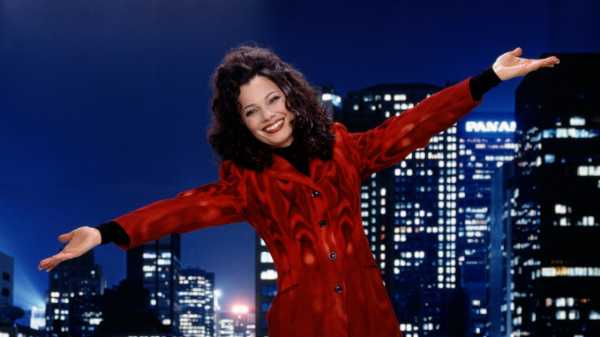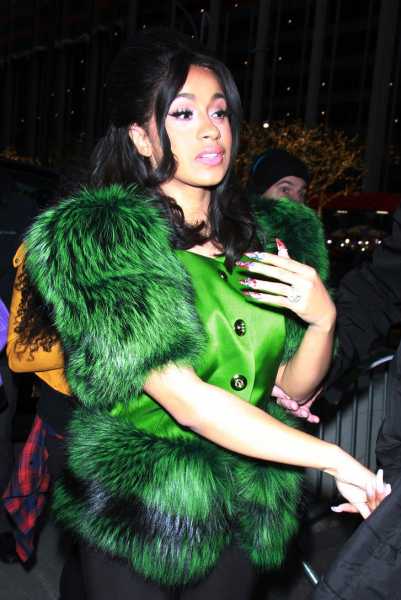
Every insomniac has her own late-night Internet-browsing routine. Mine begins with IMDb, where I like to click on the names of character actors and peruse their upcoming projects. (Weirdly soothing to know that Cloris Leachman has a lot going on!) Then I move on to nail-art blogs, where women post pictures of their manicures, featuring the season’s new colors. And, finally, I visit Net-a-Porter, to browse new clothing items that I will never be able to afford, adding thousand-dollar midiskirts to my online cart and then quietly deleting them the next day.
If you stare long enough at designer clothing in the wee hours of the morning, strange patterns begin to emerge. A few weeks ago, I began to notice that many of the Fall 2018 styles had something in common: they looked like things that Fran Drescher would have worn in the nineties CBS sitcom “The Nanny.” There are tight, leopard-print trenchcoats from Victoria Beckham and fuzzy, neon-green cropped sweaters from Balenciaga. We11Done has a line of zebra-print micro-miniskirts. Balmain is selling nip-waist patent-leather blazers with trapezoidal shoulder pads. Rosetta Getty and Roland Mouret are both pushing skin-tight pencil skirts in glazed black leather. All these items could have been plucked straight from the closet of Drescher’s Fran Fine—the Jewish-American cosmetics salesgirl from Flushing, Queens, who, through a series of lucky breaks, becomes the nanny to the children of Maxwell Sheffield, a wealthy British widower in Manhattan.
The return of “Nanny”-wear is part of a larger cloud of nineties nostalgia that seems to have enveloped the fashion world in recent years. In February, the famous yellow plaid that Alicia Silverstone wore as the Beverly Hills princess Cher Horowitz in “Clueless” appeared on the Versace runway. Fast-fashion stores like Forever 21 and H&M are now full of crushed velvet, spaghetti straps, small round sunglasses, combat boots, and lace choker necklaces. A lot of these recycled trends seem designed to recapture nineties youth culture—the teen-agers of today don’t look much different from those who graced the pages of Delia’s catalogues in 1995. But the resurgence of Fran Fine’s style is something different, a shorthand for a brash kind of femininity that commands respect without ever quite fitting in.
From its inception, “The Nanny” was a show about class. Fran Fine, with her Skittles-colored couture, unruly bouffant, and honking voice, is supposed to read as baseborn. She is a shopaholic striver with a mountain of credit-card debt, a profligate clotheshorse who, the viewer assumes, cares more about materialist trends than timeless art. (The show often pits Fran’s fashion obsession against the theatrical ambitions of her boss, a Broadway producer who is engaged in an endless rivalry with Andrew Lloyd Webber.) But much of the show’s humor comes from subverting the viewer’s assumptions. Fran outsmarts people (namely, Mr. Sheffield’s conniving, Waspy business partner, C. C. Babcock), and she dispenses wisdom, as when she suggests that the privileged children in her care might benefit, as she did, from a summer farming on a kibbutz. By the end of the series, she marries Mr. Sheffield, completing her trajectory as an outer-borough Eliza Doolittle. But, unlike Eliza’s, Fran’s taste doesn’t change. She never graduates to the muted cashmeres and neutral tones of an Upper East Side blue blood. She goes on wearing bold prints, short skirts, marabou, brocade, and leopard everything.
For the past two years, Shanae Brown, a twenty-eight-year-old hospital technician in Atlanta, has run an Instagram account called “What Fran Wore,” dedicated to cataloguing Drescher’s looks on “The Nanny.” Brown told me that the account is especially popular among young people, even though many of them “were not even born when the show was originally on the air.” The project originated when Brown started watching reruns of the series (which, vexingly, remains unavailable to stream). “That’s when I realized, Oh, my God, her outfits are really dope,” she said. She started taking screenshots, cross-referencing the images on Google and matching Drescher’s outfits with the designers who made the clothing—Moschino, Todd Oldham, Isaac Mizrahi—then posting the stills along with information about each look. Brown does not dress like Fran. (“I’m way more into athleisure wear,” she said. “I can admire her sequins, but it’s not my everyday style.”) But she has recently noticed homages to the look on celebrities like Cardi B—the black-and-white checkerboard blazer that the rapper wore on her recent album cover, she added, “is absolutely something Fran would wear.”

Cardi B on her way to “The Tonight Show” in December, 2017.
Photograph from RW / MediaPunch / IPX / AP
Cardi B, with her gleeful sartorial maximalism and Bronx patter, is the millennial generation’s most obvious Fran Fine heir. Her appearance on Jimmy Fallon’s “The Tonight Show” in December, 2017, in a very Fran-like outfit—green silk jacket, voluminous fur sleeves—sparked a Twitter campaign calling for her to star in a “Nanny” remake. Cardi has leaned into the comparison: “Fran Drescher in @dolcegabbana,” she captioned an Instagram photo from Milan Fashion Week in September, showing her in head-to-toe animal print. In a recent interview with “People,” Drescher said that she and Cardi B’s “people” had been discussing the possibility of a reboot. “Wouldn’t she be great as my daughter?” she said.
The other day, I spoke on the phone with Drescher, who was on the porch at her home in Malibu. She told me that the renewed fervor around “The Nanny” hasn’t really surprised her. “I just spoke at the Wing,” she said, referring to the women’s social club. “And those young women were thrilled to hear what I have to say, how I want them to get more woke about all this stuff going on in the world with corporate greed. They named a phone booth after me! Look, the universe is leading me down this way. Cardi B is paying homage to me. I’m not driving it, but I’m going to leverage it.”
Drescher said that in real life she “dresses more diversely” than Fran Fine but that, like the character, “I feel like I need to show off my waist, or I look dumpy.” In the time since “The Nanny” went off the air, in 1999, Drescher has devoted much of her time to activism. She is a survivor of uterine cancer and runs a women’s-health foundation called Cancer Schmancer. She’s thinking about starring in a “radical TV series” that would help people break away from industrial foods and “detox their homes.” And she can really get going on the subject of corporate greed. “On ‘The Nanny,’ Fran wouldn’t cross a picket line—her father was a union organizer. That was a subtle message I wanted in there,” she told me. “Now that I am famous, I feel responsible to speak about how we can’t give the big-business sociopaths, who pray to the money gods, power. We can’t just be mindless consumers.”
But what if one wanted to be a mindless consumer when it came to reconstructing looks from “The Nanny”? “For that, you’ll have to talk to Brenda,” Drescher said, referring to the show’s costume designer, Brenda Cooper. The two women remain close friends and go on walks together nearly every afternoon. Cooper, who still works in television, is also a private color consultant, helping clients find a palette that works for them. (Drescher’s, Cooper told me, is “dark autumn.”) And Cooper is working on a style manual that will include her fashion principles from “The Nanny”: wear form-fitting clothing, in classic silhouettes; don’t be afraid of color; and build outfits from a base layer of black turtleneck and black tights.
But none of these principles quite captures the wittiness of Fran Fine’s style—its sense that fashion can be a one-woman private joke, that labels like “tacky” and “classy” and “appropriate” can be played with and subverted at will. Cooper told me that she cemented the character’s look during the shooting of the sitcom’s pilot episode, when she put Drescher in a snug, multicolored Moschino Cheap and Chic vest, an item that Cooper keeps in her closet to this day. After that, she and an army of assistants would scour Beverly Hills each week and buy the latest fashions off the rack—Fran’s shopping addiction had to be believable. Cooper would then alter the clothing to make it more “Nanny,” cropping the blouses, shortening the skirts, embellishing with fur trim or glitter. “We would elevate the jokes with the wardrobe,” she told me. “Fran would walk into a scene, and it would be, like, Oh shit, she matches the floor!”
Sourse: newyorker.com






